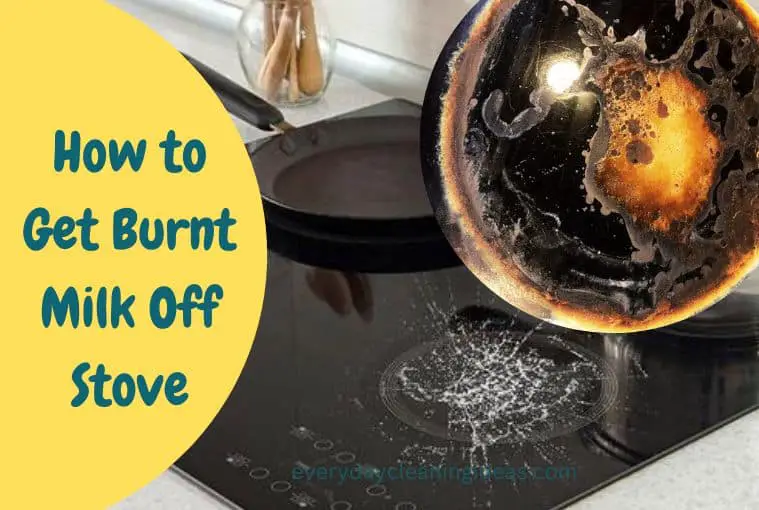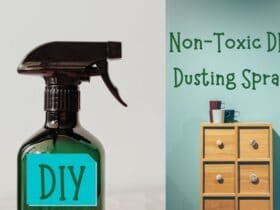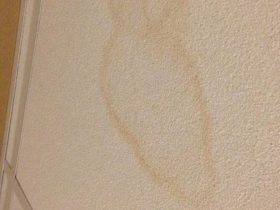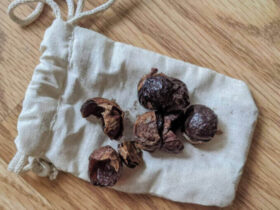Are you having trouble dealing with the scorching burnt milk off your stove? Let’s rewind a little. I know how we’ve all been there – a momentary lapse of attention, and suddenly, you find yourself dealing with the aftermath of burnt milk on your stove.
The sight of that stubborn stain can be frustrating, but fear not, as I’ve got you covered. This article is all about guiding you from what burnt milk stains look like on a stove to providing you with DIY solutions to remove them.
Additionally, we’ll delve into the specific methods for cleaning electric, glass, ceramic, and metal gas stoves, ensuring your kitchen appliance looks and feels as good as new.
What Does a Burnt Milk Stain Look Like on a Stove?
A burnt milk stain on your stove can vary in appearance, but it often resembles a brown or black, sticky residue. It clings stubbornly to the surface, making your once-pristine stove look unsightly.
Not only is it unattractive, but it can also emit an unpleasant odor when you use your stove, affecting the overall quality of your cooking experience.
6 DIYs to Help Remove Milk Stains from Gas Stoves
Why rely on others when you can remove the burnt milk stain off your stove with the help of these easy and economical DIY methods? Go on and find the solution to this problem!
- Vinegar and Baking Soda:
- Ingredients:
- White vinegar
- Baking soda
- A non-abrasive sponge or cloth
- Steps:
- Mix equal parts of white vinegar and baking soda in a bowl to create a thick paste.
- Ensure the stove is cool before proceeding.
- Apply the paste onto the burnt milk stain on your gas stove.
- Allow the paste to sit on the stain for about 15-20 minutes. This gives it time to break down the burnt milk residue.
- After the wait, use a non-abrasive sponge or cloth to gently scrub the stain.
- Rinse the area with water to remove the paste and any loosened residue.
- Dry the stove’s surface with a clean cloth.
- Lemon Juice:
- Ingredients:
- Fresh lemons or bottled lemon juice
- Steps:
- Squeeze fresh lemon juice directly onto the burnt milk stain.
- Allow the lemon juice to sit on the stain for a few minutes. The natural acids in the lemon will help break down the burnt milk.
- Gently scrub the stain with a soft cloth or sponge.
- Rinse the area with water to remove any lemon juice residue.
- Dry the surface thoroughly.
- Dish Soap and Water:
- Ingredients:
- Mild dish soap
- Warm water
- A sponge or cloth
- Steps:
- Fill a basin or sink with warm water.
- Add a few drops of mild dish soap and mix until it creates soapy water.
- Submerge the stained area or sponge in the soapy water.
- Let it soak for about 30 minutes.
- After soaking, gently scrub the burnt milk stain with a soapy sponge or cloth.
- Rinse the area with clean water to remove soap residue.
- Dry the stove’s surface with a clean cloth.
- Salt and Water:
- Ingredients:
- Table salt
- Water
- Steps:
- Mix table salt with a small amount of water to create a thick paste.
- Apply the paste to the burnt milk stain.
- Leave it on the stain for a few hours, allowing the salt to absorb and break down the burnt residue.
- After the wait, scrub the stain gently with a sponge or brush.
- Rinse the area with water to remove the salt paste.
- Dry the stove’s surface with a clean cloth.
- Razor Blade Scraper (for Glass or Ceramic Stoves):
- Tools:
- Razor blade scraper
- Steps:
- Ensure the stove is cool before beginning.
- Hold the razor blade scraper at a slight angle.
- Carefully scrape the burnt milk stain from the glass or ceramic surface.
- Be gentle to avoid scratching the surface.
- Wipe off any residue with a damp cloth.
- Dry the surface to prevent streaks.
- Commercial Stove Cleaner:
- Ingredients:
- Commercial stove cleaner (specifically designed for your stove type)
- Steps:
- Follow the manufacturer’s instructions on the commercial stove cleaner’s label.
- Typically, you’ll apply the cleaner to the burnt milk stain, let it sit for a specified time, and then scrub gently with a sponge or cloth.
- Rinse the area with water as directed.
- Dry the stove’s surface with a clean cloth.
Always exercise caution and patience when cleaning to avoid damaging your appliance while achieving the best results.
Cleaning Different Types of Gas Stoves
It is vital to know which cleaner is perfect for your gas stove. Cleaning electric, glass, ceramic, and metal gas stoves with burnt milk stains requires specific methods and cleaners tailored to each surface type.
Here’s a detailed guide for each type of stove, along with safe cleaner recommendations:
- How To Get Burnt Milk Off Electric Stove:
- Tools and Materials:
- Vinegar and baking soda paste
- Warm water
- A non-abrasive sponge or cloth
- Cleaning Steps:
- Ensure the electric stove is turned off and completely cool.
- Apply the vinegar and baking soda paste to the burnt milk stain on your electric stove.
- Let the paste sit for 15-20 minutes to break down the burnt residue.
- Gently scrub the stain with a non-abrasive sponge or cloth.
- Rinse the area with clean water to remove any remaining residue.
- Dry the stove’s surface with a clean cloth.
- Safe Cleaners for Electric Stoves:
- The vinegar and baking soda paste is a safe and effective DIY cleaner for electric stoves. Commercial stove cleaners labeled safe for electric stoves can also be used according to the manufacturer’s instructions.
- How To Get Burnt Milk Off Glass or Ceramic Stove:
- Tools and Materials:
- Razor blade scraper designed for glass or ceramic surfaces
- Warm, soapy water
- A non-abrasive sponge or cloth
- Cleaning Steps:
- Ensure the glass or ceramic stove is cool.
- Carefully use the razor blade scraper to remove the burnt milk stain. Hold it at a slight angle and gently scrape the residue.
- Wipe off any remaining residue with a damp, soapy sponge or cloth.
- Rinse the area with clean water to remove soap residue.
- Dry the stove’s surface with a clean cloth to prevent streaks.
- Safe Cleaners for Glass or Ceramic Stoves:
- A razor blade scraper is the safest option for these surfaces. Avoid abrasive cleaners or tools that can scratch the glass or ceramic. Always check your stove’s manufacturer recommendations for specific cleaners.
- How To Get Burnt Milk Metal Gas Stove:
- Tools and Materials:
- Warm, soapy water
- Non-abrasive sponge or cloth
- Commercial stove cleaner suitable for metal stoves
- Cleaning Steps:
- Remove the grates and burner caps from the metal gas stove.
- Soak these parts in warm, soapy water to loosen burnt milk residue.
- After soaking, scrub the grates and burner caps with a brush or non-abrasive sponge to remove any remaining residue.
- Apply a commercial stove cleaner that is safe for metal stoves to the metal surface.
- Gently scrub the burnt milk stain with a sponge or cloth.
- Rinse the area with clean water to remove cleaner residue.
- Dry the stove’s surface with a clean cloth.
- Reassemble the grates and burner caps.
- Safe Cleaners for Metal Gas Stoves:
- Commercial stove cleaners labeled safe for metal stoves are the best choice for these surfaces. Ensure the product is suitable for your specific stove type and follow the manufacturer’s instructions.
Remember to always follow safety precautions and manufacturer recommendations when using cleaning products on your stove.
Using the right cleaner and method for your stove type will help you effectively remove burnt milk stains without causing damage.
Pro Tips for Safely Removing the Stain Without Harming the Stove
- Always ensure the stove is cool before attempting to clean it.
- Test any cleaning solution in a small, inconspicuous area first to check for any adverse reactions.
- Use gentle, non-abrasive materials to avoid scratching the surface.
- Follow the manufacturer’s instructions if you’re using a commercial cleaner.
- For tough stains, be patient and repeat the cleaning process if necessary.
FAQs
1. Can I use a metal scraper on a glass or ceramic stove?
Using a metal scraper on a glass or ceramic stove is not recommended. These surfaces are delicate and can easily scratch, so it’s important to be cautious.
Instead, opt for a razor blade scraper specifically designed for glass or ceramic surfaces. These tools are gentler and less likely to cause damage.
When using the scraper, hold it at a slight angle and be gentle while removing burnt milk stains to avoid any scratches.
2. Is it safe to use bleach to remove burnt milk stains?
It is generally not safe to use bleach to remove burnt milk stains from your stove. Bleach can be harsh and may damage the finish or discolor the surface of your stove.
Additionally, the strong odor of bleach can linger, affecting the taste and smell of your food during cooking.
3. Can I use a scouring pad to remove the burnt milk stain?
Using a scouring pad to remove burnt milk stains should be avoided in most cases. Scouring pads can be abrasive and may scratch the surface of your stove, especially if it’s made of glass or ceramic.
4. How often should I clean my stove to prevent burnt milk stains?
To prevent burnt milk stains and maintain the cleanliness of your stove, it’s advisable to clean it regularly.
After each use, allow the stove to cool and wipe away any spills or splatters promptly. A weekly deep cleaning routine can help prevent stubborn stains from building up over time.
Regular maintenance will not only keep your stove looking its best but also improve its longevity and functionality.
5. Can I use the same cleaning method for stainless steel gas stoves?
Yes, you can use similar cleaning methods for stainless steel gas stoves as those mentioned in the article.
However, stainless steel is prone to streaking and watermarks, so after cleaning, be sure to dry the surface with a clean cloth to maintain its shine. Avoid abrasive materials or harsh chemicals that can scratch or damage the stainless steel finish.
If you choose to use a commercial cleaner, ensure that it’s labeled safe for stainless steel and follow the manufacturer’s recommendations for best results.
Summing It Up
Dealing with burnt milk stains on your stove may seem like a daunting task, but with the right DIY solutions and cleaning techniques, you can restore your stove to its pristine condition.
Remember to choose the appropriate method for your stove type and follow safety precautions to ensure a successful and safe cleaning process. Say goodbye to unsightly burnt milk stains and hello to a clean, beautiful kitchen appliance!









Leave a Reply
View Comments